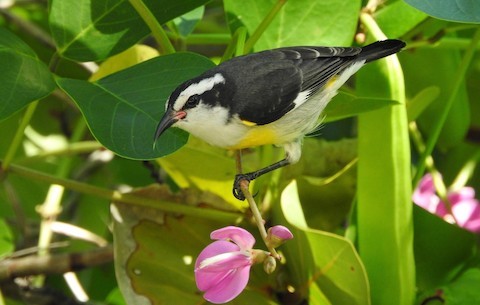Birdfinding.info ⇒ The Bahamian form of Bananaquit is common or abundant on most islands from Abaco, Andros, and New Providence to Great Inagua and Grand Turk, but uncommon or sporadic on Grand Bahama. Most Florida records have been clustered around Fort Lauderdale and Key Biscayne; most Cuban records on the Jardines del Rey Archipelago, especially Cayo Coco and Paredón Grande.
“Bahama Bananaquit”
Coereba flaveola bahamensis
Endemic to the Bahamas and Turks & Caicos. Occurs nearly throughout the Lucayan Archipelago, on all the major islands and many of the small ones.
Fairly frequent as a vagrant to southeastern Florida and Cuba—presumably in part because it inhabits many small islands and therefore must be adapted to dispersing over water.
Identification
Like all Bananaquits, readily recognized by its curved, sharp-tipped bill, broad white eyebrows, dark brown mask and upperparts, and yellow breast—but on “Bahama” the yellow is limited to a shield-shaped patch on the mid-breast.
Other distinctive features include a pink gape, yellow rump, yellow shoulders, and a large white spot at the base of the primaries.

“Bahama Bananaquit,” C. f. bahamensis. (Madeira, Great Exuma, Bahamas; October 25, 2016.) © Lorraine Minns
The “Bahama Bananaquit” closely resembles the Bananaquit forms that inhabit the Cayman Islands, Cozumel, Providencia, and San Andrés. These forms all have a whitish throat that extends down to the upper chest and blends into the yellow of the breast—whereas the “Greater Antillean”, “Lesser Antillean”, and “Continental” forms have a smaller, dark gray throat that contrasts sharply with the vivid yellow chest.
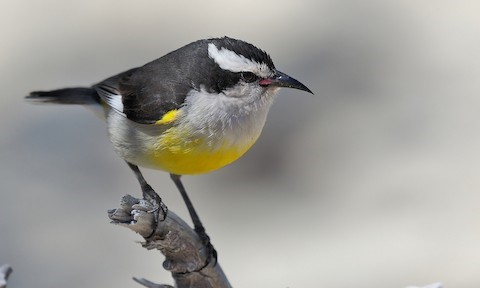
“Bahama Bananaquit,” C. f. bahamensis, showing its broad white eyebrow. (Allan’s Cays, Bahamas; April 7, 2017.) © Adrián Braidotti
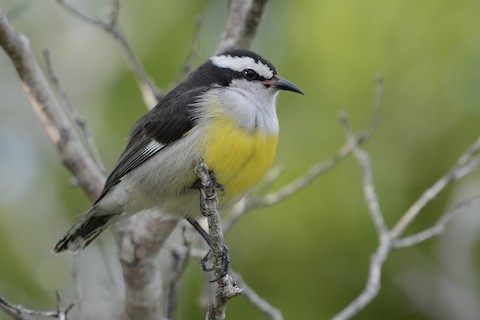
“Bahama Bananaquit,” C. f. bahamensis, with an unusually subtle shade of yellow on the breast. (Stocking Island, Great Exuma, Bahamas; January 6, 2019.) © Bridget Spencer
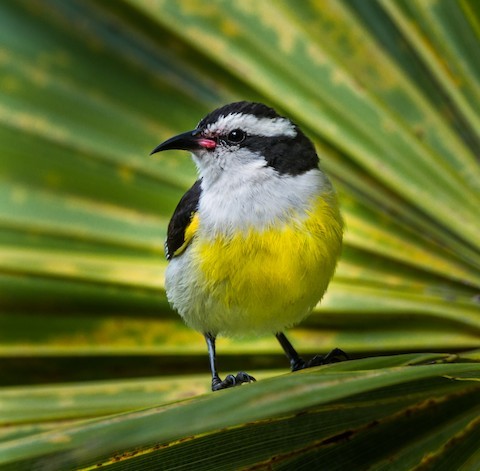
“Bahama Bananaquit,” C. f. bahamensis. (Leon Levy Native Plant Perserve, Central Eleuthera, Bahamas; April 10, 2019.) © Jim Merritt
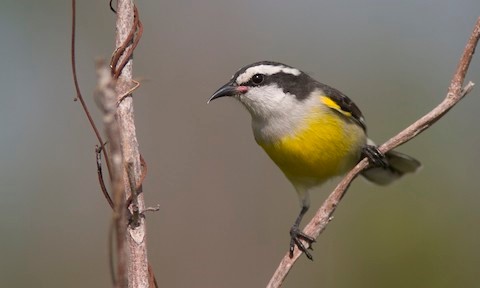
“Bahama Bananaquit,” C. f. bahamensis. (Crossing Rocks, Abaco, Bahamas; November 25, 2006.) © Brian Sullivan
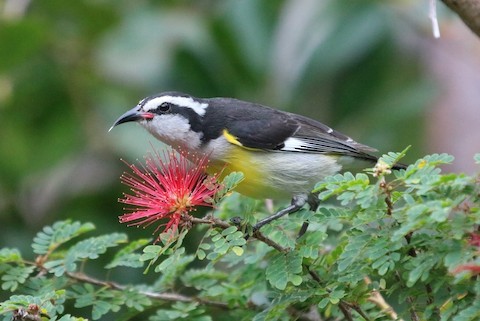
“Bahama Bananaquit,” C. f. bahamensis, with its tongue extended. (Castaway Cay, Bahamas; February 3, 2018.) © Philip Andescavage
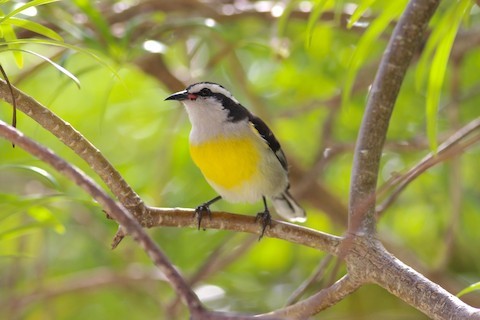
“Bahama Bananaquit,” C. f. bahamensis. (Banks Road, Central Eleuthera, Bahamas; December 25, 2015.) © Jamie Adams
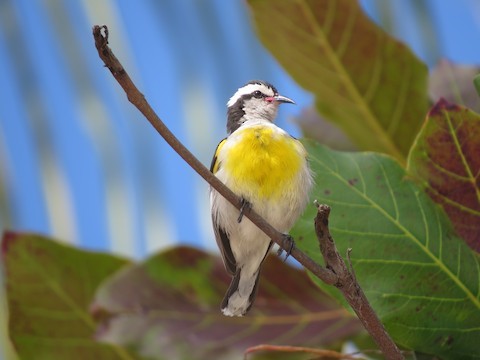
“Bahama Bananaquit,” C. f. bahamensis. (Princess Cays, South Eleuthera, Bahamas; January 19, 2014.) © MA McCar

“Bahama Bananaquit,” C. f. bahamensis. (Mayaguana, Bahamas; February 12, 2020.) © Kamella Boulle

“Bahama Bananaquit,” C. f. bahamensis. (Castaway Cay, Bahamas; October 27, 2016.) © Erika Gates
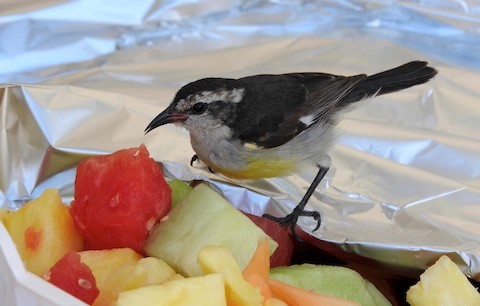
“Bahama Bananaquit,” C. f. bahamensis. (Princess Cays, South Eleuthera, Bahamas; December 9, 2019.) © Noam Markus
Immatures are similar to adults but duller, with grayish-brown upperparts, pale-gray underparts, and a faint yellowish wash on the breast.
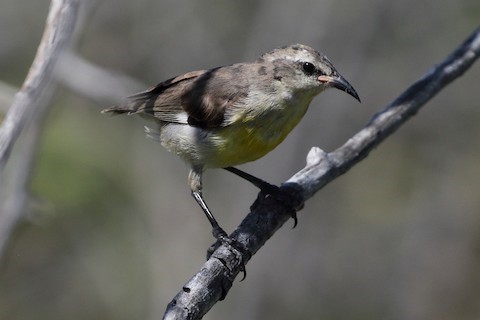
“Bahama Bananaquit,” C. f. bahamensis, immature. (Cayo Paredón Grande, Ciego de Ávila, Cuba; February 10, 2020.) © Christopher Escott
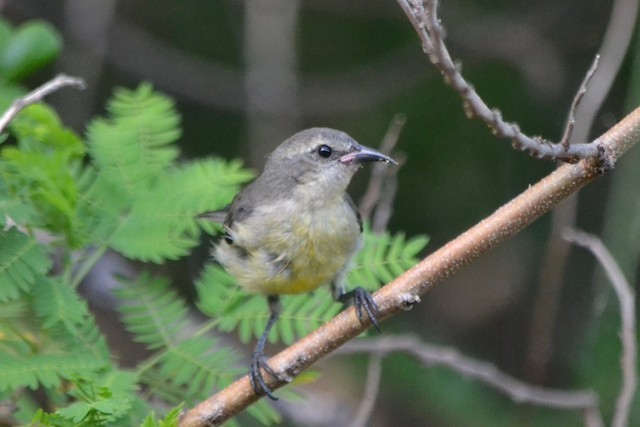
“Bahama Bananaquit,” C. f. bahamensis, immature. (Central Eleuthera, Bahamas; August 8, 2018.) © Will Johnson
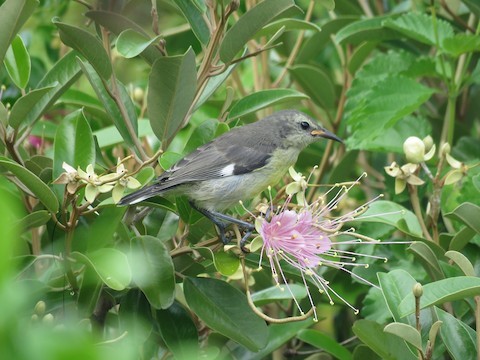
“Bahama Bananaquit,” C. f. bahamensis, immature. (Highborne Cay, Bahamas; June 12, 2018.) © Jeanne Kaufman
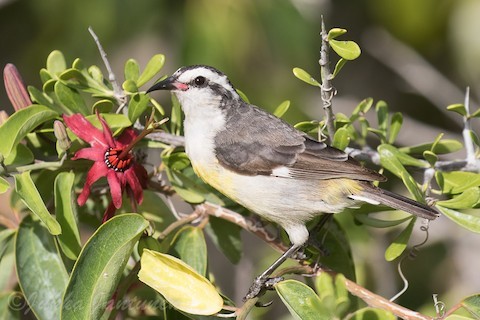
“Bahama Bananaquit,” C. f. bahamensis, subadult (Cayo Paredón Grande, Ciego de Ávila, Cuba; March 1, 2017.) © Jukka Jantunen
Notes
Monotypic form, one of approximately five to ten potentially distinct forms of Bananaquit. The Bahama form is often grouped together with the “Cozumel” form. It also resembles the “Cayman” and “Providencia” forms in appearance, but differs vocally from all of them.
Frontiers of Taxonomy: Bunches of Bananaquits. The 43 or so subspecies of Bananaquit vary significantly in plumage and voice, and it seems clear that what has traditionally been recognized as a single species consists of several distinguishable forms, and likely two or more species, but it is a complex puzzle.
Mitochondrial DNA analysis (Bellemain et al. 2008) indicates that the oldest splits are among three lineages: “Bahama” (bahamensis, plus the “Cozumel” subspecies, caboti); “Greater Antillean” (Jamaican flaveola, Hispaniolan bananivora, “Cayman” sharpei, and possibly also the similar “Providencia” form, which includes tricolor and oblita); and the rest (which can be subdivided into “Lesser Antillean” and “Continental” groups).
References
Alderfer, J., and J.L. Dunn. 2014. National Geographic Complete Birds of North America (Second Edition). National Geographic Society, Washington, D.C.
Bellemain, E., E. Bermingham, and R.E. Ricklefs. 2008. The dynamic evolutionary history of the bananaquit (Coereba flaveola) in the Caribbean revealed by a multigene analysis. Evolutionary Biology 8:240.
Bellemain, E., O.E. Gaggiotti, A. Fahey, E. Bermingham, and R.E. Ricklefs. 2012. Demographic history and genetic diversity in West Indian Coereba flaveola populations. Genetica 140:137-148.
BirdLife International. 2016. Coereba flaveola. The IUCN Red List of Threatened Species 2016: e.T22722080A94747415. https://dx.doi.org/10.2305/IUCN.UK.2016-3.RLTS.T22722080A94747415.en. (Accessed April 21, 2021.)
eBird. 2021. eBird: An online database of bird distribution and abundance. Cornell Lab of Ornithology, Ithaca, N.Y. http://www.ebird.org. (Accessed April 21, 2021.)
Howell, S.N.G., I. Lewington, and W. Russell. 2014. Rare Birds of North America. Princeton University Press.
Kirwan, G.M., A. Levesque, M. Oberle, and C.J. Sharpe. 2019. Birds of the West Indies. Lynx Edicions, Barcelona.
Raffaele, H., J. Wiley, O. Garrido, A. Keith, and J. Raffaele. 1998. A Guide to the Birds of the West Indies. Princeton University Press, Princeton, N.J.
Seutin, G., N.K. Klein, R.E. Ricklefs, and E. Bermingham. 1994. Historical Biogeography of the Bananaquit (Coereba flaveola) in the Caribbean Region: A Mitochondrial DNA Assessment. Evolution 48:1041-1061.
Xeno-Canto. 2021. Bananaquit – Coereba flaveola. https://www.xeno-canto.org/species/Coereba-flaveola. (Accessed April 21, 2021.)
